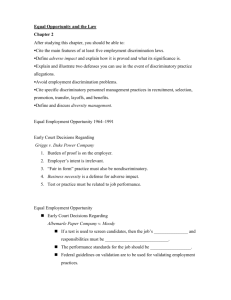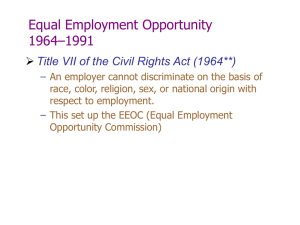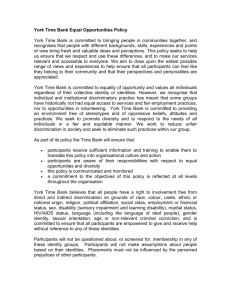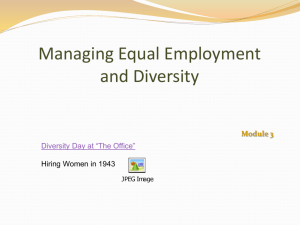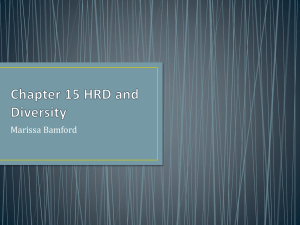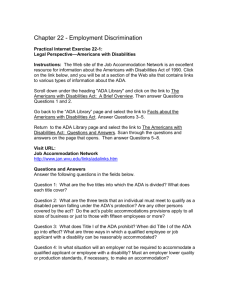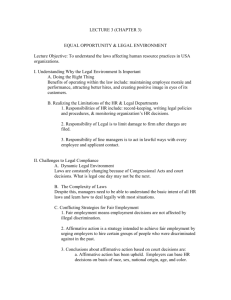HRM 2
advertisement
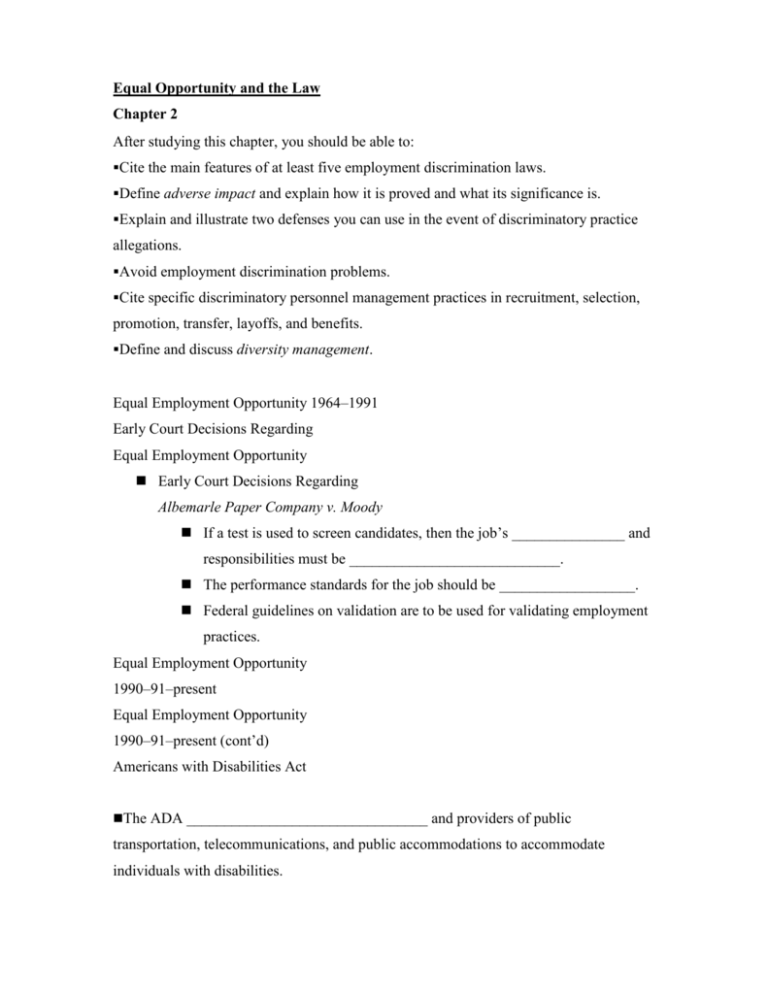
Equal Opportunity and the Law Chapter 2 After studying this chapter, you should be able to: Cite the main features of at least five employment discrimination laws. Define adverse impact and explain how it is proved and what its significance is. Explain and illustrate two defenses you can use in the event of discriminatory practice allegations. Avoid employment discrimination problems. Cite specific discriminatory personnel management practices in recruitment, selection, promotion, transfer, layoffs, and benefits. Define and discuss diversity management. Equal Employment Opportunity 1964–1991 Early Court Decisions Regarding Equal Employment Opportunity Early Court Decisions Regarding Albemarle Paper Company v. Moody If a test is used to screen candidates, then the job’s _______________ and responsibilities must be ____________________________. The performance standards for the job should be __________________. Federal guidelines on validation are to be used for validating employment practices. Equal Employment Opportunity 1990–91–present Equal Employment Opportunity 1990–91–present (cont’d) Americans with Disabilities Act The ADA ________________________________ and providers of public transportation, telecommunications, and public accommodations to accommodate individuals with disabilities. Title I of the ADA prohibits employment discrimination against qualified individuals with disabilities. Equal Employment Opportunity Commission (EEOC) The federal administrative agency responsible for _____________ most federal anti- discrimination laws. The EEOC is empowered to: Conduct __________________ __________________ the statutes Encourage __________________ _____________ between _________________________________ to enforce the law Department of Fair Employment and Housing Carper/2001 California Partnership Employer Obligations Under ADA An employer must make a _________________ for a qualified disabled individual unless doing so would result in ________hardship. Employers are not required to __________________________________ or ____ using _____ for a job. Employers may ask pre-employment questions about ______________________ but can not make inquiries about disability. Medical exams (or testing) for current employees must be Employers job-related. should review job application forms, interview procedures, and job descriptions for illegal questions and statements. Employers should have _________________ job descriptions that identify the current essential functions of the job. Disabilities and ADA Courts will tend to define “disabilities” quite narrowly. Employers are ____________________ to tolerate ______________or __________ performance, even if the behaviors can be attributed to the disability. Employers _______________________________________ for the disabled worker nor reassign that person to a light-duty position for an indefinite period, unless such a position exists. Employers should not treat employees as if they are disabled so that they will not be “_________________” disabled and protected under the ADA. State and Local Equal Employment Opportunity Laws State and Local Laws Cannot conflict with federal law but can extend coverage to additional protected groups. The EEOC can defer a discrimination charge to state and local agencies that have comparable jurisdiction. Title VII: Sexual Harassment Sexual Harassment Harassment on the basis of sex that has the purpose or effect of substantially interfering with a person’s work performance or creating an intimidating, hostile, or offensive work environment. Employers have an affirmative duty to maintain workplaces free of sexual harassment and intimidation. Federal Violence Against Women Act of 1994 A person who commits a violent crime motivated by gender is liable to the party injured. Proving Sexual Harassment TABLE 2–2 Summary of Important Equal Employment Opportunity Actions Sexual Harassment: Court Decisions Lets Exam the changing of these laws Justice Antonin Scalia “US Supreme court held that sexual harassment law doesn’t cover ordinary “_________________________” In this ruling, Justice Antonin Scalia said courts must carefully _____________ between “simple teasing and truly abusive behavior.” March 04, 2008 Court Examines Workplace Flirtation What the court said. In order to prove a hostile work environment claim, the employee had to show: (1) that she ______________________________ because of her sex, (2) the discrimination was severe or pervasive, (3) it _________________ affected her, (4) it would have detrimentally affected a ____________________ in like circumstances, and (5) there is a basis for employer liability. The court examined the manager's behavior against this standard. FIGURE 2–1 HR in Practice: What Employers Should Do to Minimize Liability in Sexual Harassment Claims FIGURE 2–2 California State University, Fresno: Complaint Form for Filing a Complaint of Harassment or Discrimination Adverse Impact Showing Disparate Treatment Bona Fide Occupational Qualification Business Necessity “Business Necessity” A defense requiring employers to show that there is an _______________________ (i.e., “irresistible demand”) for a discriminatory practice. Spurlock v. United Airlines Validity The degree to which the test or other employment practice is related to or predicts performance on the job can serve as a business necessity defense. Hooters Settles Suit By Men Denied Jobs Hooters Unable to Justify BFOQ Settles Other Considerations in Discriminatory Practice Defenses •______________________ are no excuse. •Employers cannot hide behind collective bargaining agreements—equal opportunity laws override union contract agreements. •Firms should react by agreeing to eliminate an illegal practice and (when required) by compensating the people discriminated against. Discriminatory Employment Practices The EEOC Enforcement Process FIGURE 2–4 The EEOC ChargeFiling Process FIGURE 2–3 Questions to Ask When an Employer Receives Notice That EEOC Has Filed a Bias Claim Mandatory Arbitration Gilmer v. Interstate/Johnson Lane Corp. Employers can compel employees to agree to ___________________ of employment- related disputes. Recommendations Request Insert party be __________ to arbitrate claim. arbitration clause in employment ___________ and employee ______________. Protect arbitration process from appeal. Alternative Dispute Resolution (ADR) Addressing EEOC Claims Addressing EEOC Claims (cont’d) Diversity Management Program Is the Diversity Initiative Effective? Are there women and minorities reporting directly to senior managers? Do women and minorities have a fair share of job assignments that are stepping stones to successful careers in the company? Do women and minorities have equal access to international assignments? Are female and minority candidates in the company’s career development pipeline? Are turnover rates for female and minority managers the same or lower than those for white male managers? Designing an Affirmative Action Program _____________________ Strategy Eliminating the present effects of past practices that excluded or underutilized protected groups. Identification through ___________________________. Proactive elimination of ______________________________. Increased minority or female applicant flow. Increasing Employee Support for Affirmative Action Transparent selection procedures Communication Justifications Steps in an Affirmative Action Program 1. Issues a written ___________________________. 2. ___________________________ to direct and implement the program. 3. Publicizes the equal employment policy and affirmative action commitment. 4. Surveys minority and female employment to determine where affirmative action programs are especially desirable. 5. Develops _______________________ to improve utilization of minorities, males, and females. 6. Develops and implements ______________________ to achieve these goals. 7. Establishes an audit and reporting system to monitor and evaluate progress of the program. 8. Develops support for the affirmative action program, both inside the company and in the community. Reverse Discrimination Reverse Discrimination Discrimination against non-minority applicants and employees by quota-based systems. Bakke v. Regents of the University of California Wygant v. Jackson Board of Education U.S. v. Paradise Johnson v. Transportation Agency, Santa Clara County KEY TERMS 1. Title VII of the 1964 Civil Rights Act 2. Equal Employment Opportunity Commission (EEOC) 3. affirmative action 4. Office of Federal Contract Compliance Programs (OFCCP) 5. Equal Pay Act of 1963 6. Age Discrimination in Employment Act 7. of 1967 (ADEA) 8. Vocational Rehabilitation Act of 1973 9. Vietnam Era Veterans’ Readjustment Act of 1974 10. Pregnancy Discrimination Act (PDA) 11. uniform guidelines 12. sexual harassment 13. Federal Violence Against Women Act 14. of 1994 15. protected class 16. Civil Rights Act of 1991 (CRA 1991) 17. mixed motive case 18. Americans with Disabilities Act (ADA) 19. qualified individuals 20. adverse impact 21. disparate rejection rates 22. restricted policy 23. bona fide occupational qualification (BFOQ) 24. alternative dispute resolution or ADR program 25. good faith effort strategy 26. reverse discrimination
